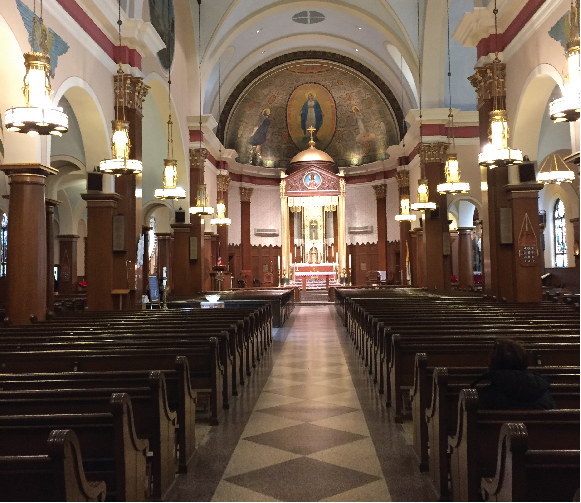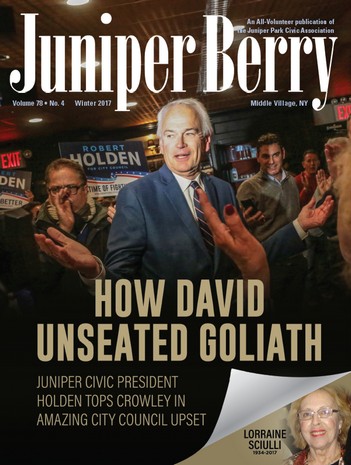2017 marks the 100th year of Our Lady of the Miraculous Medal parish serving the Roman Catholic community of Ridgewood, Middle Village and Maspeth. In May of 1917 the Bishop of the Brooklyn Diocese, Charles McDonnell, determined the need for a new parish to accommodate the rapid development of the area then known as Fresh Pond. The resident Catholics had been travelling to St. Aloysius (which celebrated its 125th anniversary this year), St. Stanislaus and St. Matthias, all a bit too distant, for Sunday and Holy Day services. Thusly OLMM was conceived.
The Bishop appointed Father John J. Oppel to lead the formation of OLMM and he moved rapidly with this task securing a rectory on Menahan Street (then called Ralph Street) and a site to celebrate Mass. Father Oppel chose Montauk Hall as a temporary site and the owner generously offered its use at no charge. The first Masses were celebrated on July 8th and over four hundred new parishioners attended. Father Oppel also established many parishioner groups including altar boys, ushers, ladies Altar Society, Social club and Catholic Club.
The next task was finding and acquiring property to erect a church, rectory and eventually a convent and school. This was accomplished by purchasing thirty-two building lots along Sixty-First Street and Sixtieth Place bounded by Bleecker Street. By summer of 1918 the first church was completed. The building faced Bleecker Street and could seat five-hundred parishioners. Finally on August 4th, 1918, Father Oppel celebrated the first mass and oversaw the First Communion ceremony for many of the youngsters.
Construction of the rectory was Father Oppel’s next project and it was completed in 1922. The parish was now growing at breakneck speed and Father Sylvester Ronaghan, the future pastor, was assigned to OLMM to assist Oppel and a year later Father John Mulz joined the duo.
Ever attending to the parish’s needs Father Oppel planned for a four story parish school which was erected above almost all of the church structure. The entrance was moved to Sixty-First Street and the expanded church was capable of containing one thousand worshippers. The first Mass was held at midnight on Christmas Eve 1928. The school occupied the second and third floors of the building and the fourth was utilized as a temporary convent for the Sisters of Notre Dame de Namur while a permanent one was being built. On September 9th , 1929, the school opened with almost 600 pupils in classes 1 through 5.
Later in 1929 financial disaster struck the nation and OLMM was not spared. Many parishioners lost their jobs and means of income. This affected the parish in many ways. Father Ronaghan headed the Saint Vincent de Paul Society which assisted almost one-hundred parishioners with daily necessities.
The convent was miraculously completed in 1933 and the Sisters moved into their new home. This year also saw the first graduating class, consisting of twenty-six students, from the school. The school was also growing due to the exacting quality of instruction provided by the sisters and the dedication of parents to their children’s education.
In 1935 Oppel, now a Monsignor, contemplated a drive to retire all mortgages on the parish buildings. The drive was inaugurated in the spring of 1937 and many attractions such as fairs, bingo, talent shows, booster chances and dances held. On August 16th, 1937, the drive was completed and the mortgages burned in front of a crowd estimated to be in the thousands.
Never one to let grass grow under his feet Msgr. Oppel began planning for a new church he believed his parishioners deserved. In September of 1940 ground was broken for the present structure and the cornerstone was laid on November 30, 1941. Less than one year later the church was completed. On November 28, 1942 dedication ceremonies were led by Bishop Molloy and a high Mass was celebrated
OLMM at this time contributed mightily to our nation’s military involvement in World War II. Over 1,250 men and women served the war effort and 23 lost their lives in the effort. After returning home many of the service man and women returned to the parish and married in the beautiful new church. They had families and many attend the parish school.
On January 20th founding pastor Right Reverend Monsignor John Oppel passed from this earth. The following Friday a funeral Mass was held in the church for the Monsignor. Many of his fellow Monsignors, present and past priests attended the service as well as his beloved parishioners. Archbishop Molloy presided and gave final absolution. Monsignor was laid to rest in St. John Cemetery.
In mid-February Father Ronaghan returned to OLMM as pastor. During His absence the parish grew exponentially and he was determined to continue the advancement. Under his reign activities for the young expanded to include additional C.Y.O. sports for boys and girls, an award winning Drum and Bugle corps was established, boy girl scouts troops were enlarged. In addition membership in adult activities also increased. Father Ronaghan also re-decorated the church interior with the addition of a beautiful mural of the parish’s namesake above the altars canopy
In March of 1961 Father Ronaghan was elevated to Right Reverend Monsignor and in the same year he initiated an expansion of the school and so as not to take away from the school yard the addition was elevated over the lunch room.
Many changes were occurring in the faith at this time. The Second Vatican Council allowed the Mass to be said in English, the altar was reversed so the officiant faced those in attendance at the service, lay lectors were added and many liturgical changes took place.
Despite the many changes the church moved forward in the 1960’s. Late in the decade Monsignor became pastor emeritus and Father Howard McMonagle assumed the role of pastor.
Masses were now being said not only in English but in German and Italian starting a tradition that exists today with Polish Masses. Later in 1968 the Sisters of Notre Dame de Namur announced that they would cease to teach at OLMM to pursue other community disciplines. A lay principal was appointed and additional lay teachers were added to the faculty and the school continued its tradition of providing an exemplary Roman Catholic education to the students of the parish.
In 1979 Extraordinary Ministers were introduced to the parrish assisting the priests at Mass and the distribution of the Holy Eucharist to worshippers and the home bound and incapable of attending.
Father McMonagle retired in 1981 leaving the parish in superb order. He was replaced by Father William Davis who handled many of the societal problems affecting all religions at the time with aplomb and grace.
Father Davis expanded CCD and fought rising tuition and dropping enrollment at the school. He made several remarkable changes to the church by relocating the Baptismal Font opening up the church basement to groups seeking meeting space. He also renovated the rectory which was in sore need of repair.
In 1991 Monsignor George Schuster became the Pastor. He had previous experience as Pastor of St. Aloysius and he led OLMM is a strong and dedicated fashion during continued times of change. Monsignor retired in June of 1982 and was succeeded by Monsignor Edward “Ned” Ryan.
With Monsignor Ryan at the helm the parish maintained a strong presence in the area and continued to provide quality Catholic education at the school. One major change occurred during the Monsignor’s reign, the school was renamed Notre Dame Academy remembering the wonderful Sisters of Notre Dame who taught at the school for many years.
Monsignor Ryan retired in 2012 and Father Anthony Sansone was named to replace him. Fr. Anthony, as he is called, was very familiar with OLMM having previously served at St. Aloysius. Under Father Anthony the campus has been transformed into a more modern and parishioner attentive church. Many improvements have taken place including the refurbishing and repainting of the church interior allowing the wonderful murals to become brightened and more recognizable. A Shrine to St. Anne is being added as well as an altar honoring Our Lady of Częstochowa also known as The Black Madonna.
Our Lady of the Miraculous Medal has always been a vibrant religious community and home to many immigrant groups from the original German founders to Italian, Irish, Hispanic, Asian Pacific and Polish worshippers. The robust faith of OLMM’s parishioners and its continued capable leadership assure a successful future as it continues into its second century.




